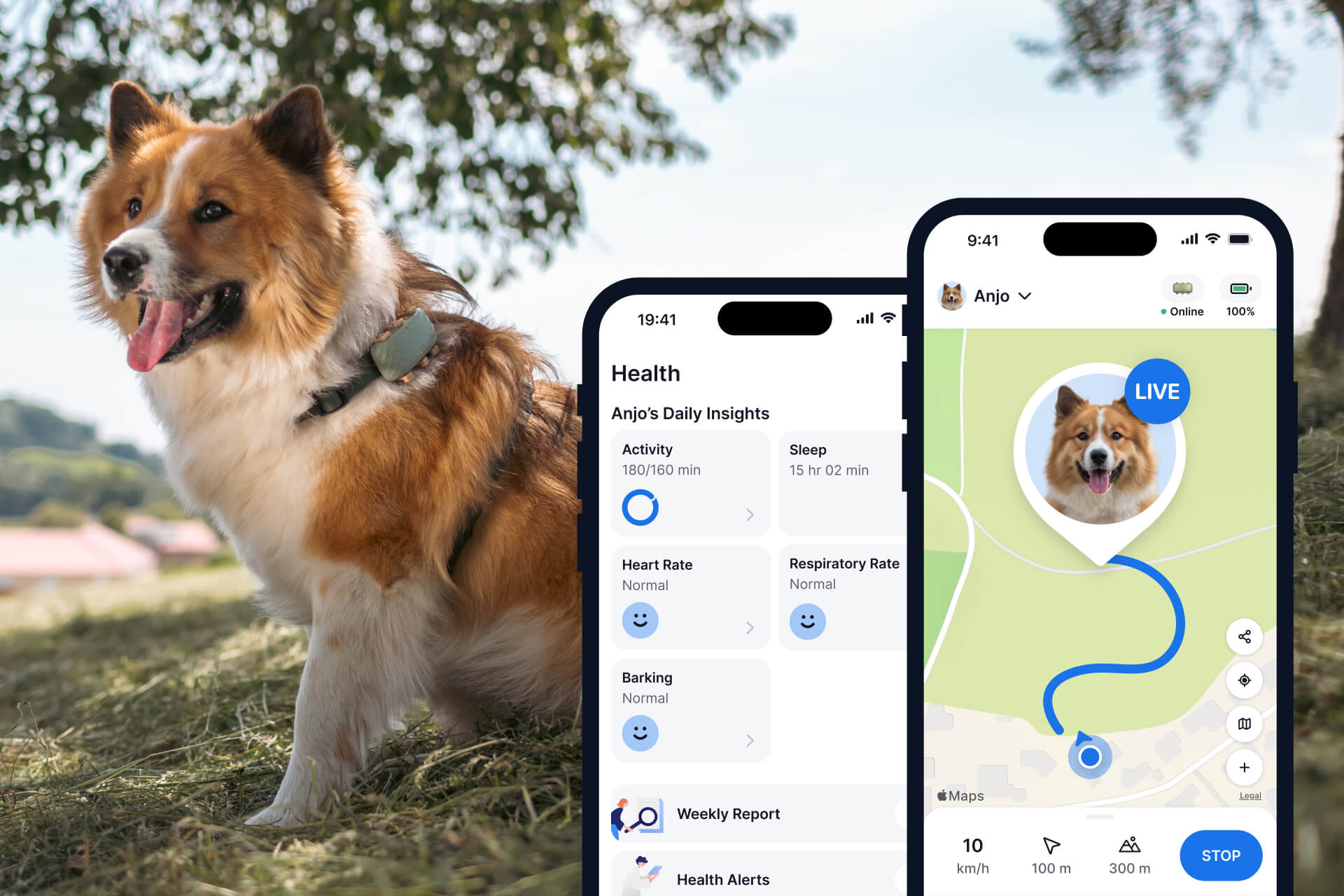 Approved by Dr. Dwight Alleyne, DVM
Approved by Dr. Dwight Alleyne, DVM Why Is My Dog Throwing Up? 8 Reasons Why & What To Do
Bad case of the canine barfing blues? The reasons your dog might be throwing up can range from mild, temporary ones - to more severe health concerns. Here are some of them & what you can do to prevent them + get your buddy the help they need.

Let’s face it – coming home to find your dog sitting proudly next to a mountain of dried vomit isn’t fun. In fact, around 52% of pet owners worry about their dog throwing up unexpectedly!1 So once you’re done cleaning up the mess, you might’ve wondered: why is my dog throwing up? Here are 8 reasons why, what to do, and how to figure out where they might be dumpster diving.

Always know your buddy is healthy & safe
Read moreWhy is my dog throwing up? The most common reasons
Now depending on what exactly your dog is throwing up, it might not necessarily be an emergency. A bit of hacking, gagging, and even barfing isn’t always a cause of concern. In fact, sometimes throwing up can be a lifesaving mechanism that prevents your dog from getting poisoned.
Vomiting is how our bodies rid themselves of harmful bacteria or toxins. So the reasons your dog is throwing up might range from minor and temporary – like motion sickness – to more serious health concerns. Here are some of the more common reasons.
- Your dog ate too much, too quickly
In these cases, your dog might not really have thrown up – but simply regurgitated instead. I.e., when they seem to “vomit” mostly bits of undigested foods. Regurgitated food can turn up as brown vomit. Your dog might also barf it back up if they’ve swallowed some air while chewing and swallowing.1 - You’ve switched up your dog’s diet or meds
This reason might also answer the question: why is my dog throwing up undigested food hours after eating? I.e., your dog might eat some new food way too quickly, or too much of it, or their system might not be used to a change. - Your dog’s exercised too soon after eating
Which means their stomachs might not have fully digested the food before it ends up outside.
Medical reasons your dog might be vomiting
- Your dog’s eaten or drunk something they shouldn’t have
Including trash, spoiled food, dirty water, something from your kitchen, their own poop, a foreign object (like a toy), something toxic, or even grass. In these cases, your dog might experience gastritis (an upset stomach) or more seriously, gastroentritis.2 - Your dog’s suffering an infection
Eating something off-limits might result in an infection from bacteria, viruses, or even fungi – depending on what they’ve eaten. Once your dog’s system figures out it’s being attacked by intestinal parasites, it might trigger a vomiting episode to rid your dog’s bodies of these harmful substances. - Your dog’s experiencing heat stroke
Vomiting is actually one of the lesser known symptoms of heat stroke. Dogs overheat when their body temperatures soar above 39°C. Make sure to stay informed on the signs of heat stress, heat exhaustion, and heat stroke in dogs – and keep your buddy safe.

Get health alerts for your dog
Our pups can’t always tell us if something’s wrong. But if their tracker detects unusual changes in their routine, you’ll get an alert, helping you catch potential issues early.
Something’s built up in your dog’s stomach
Your dog’s stomach might end up with a buildup of different substances – all of which might show up as different types of vomit. So as gross as it might be, keep an eye out for these signs and make sure to get your dog to a vet as soon as you can if you see any of these.
- Why is my dog throwing up green vomit? Or grass?
Green vomit might be a sign your dog’s eaten grass – whether from your lawn or your neighbors’ or the neighborhood park. It could also indicate your dog’s stomach has a buildup of bile. (Which might also turn up as yellow vomit.)3 - Why is my dog throwing up white foam?
Stomach acid buildup might lead your dog might throw up white, foamy vomit instead. - Why is my dog throwing up clear vomit? Or slimy vomit?
In some cases, water might pool in your dog’s stomach instead – resulting in clear, almost liquid vomit. Or, if your dog’s drool builds up in their stomach, it might result in “slimy” vomit that looks like mucus. - Why is my dog throwing up blood?
Blood in your dog’s vomit may indicate that your dog’s gastrointestinal (GI) tract is pooling with blood. Your dog’s stomach or small intestines might be bleeding if you notice blood clots, fresh blood, or vomit resembling coffee grounds. It might be the result of a tumor, blood clotting problems, or if they’ve eaten something highly toxic.4
Other health conditions that might cause vomiting in dogs
- Addison’s disease
- Bloating, or gastric dilation and volvulus
- Cancer
- Diabetes
- Food allergies
- Inflammatory bowel disease (IBD)
- Hemmorhagic gastroentritis
- Kidney disease
- Liver disease
- Meningitis
- Pancreatitis
- Parvovirus
- Tumors
- Ulcers
Parvovirus, in particular, is contagious – and one of the most common health conditions that might cause a dog to vomit. If you’re regularly boarding your dog or they’re hanging out with other dogs in big groups quite often, there’s always the risk they might catch it. Puppies and certain dog breeds (especially working dog breeds) are especially vulnerable to it. Parvovirus usually begins with symptoms like lethargy – followed by vomiting and a drop in your dog’s appetite.8
Just remember: only a vet can provide you a 100% proper diagnosis. Get your dog to a vet immediately if you notice any of these signs.
Dog throwing up: What signs to watch out for
Now if your dog has been throwing up for less than half a day (or around 12 hours) and seems able to eat and drink normally, give it a little time before you head to your vet. However, here are some situations where you need to make an emergency vet visit. Head over to your vet immediately if you’re noticing:
- Vomiting accompanied with diarrhea (especially if it’s bloody)
- Bloody vomit
- Your dog is extremely lethargic after vomiting – or shaking uncontrollably
- Your dog has just swallowed a foreign object or something toxic
- Your dog is projectile vomiting (which might indicate they’ve swallowed a foreign object)
- Your dog is dry heaving – but nothing is coming out
Got a puppy or a senior dog at home? They’re more vulnerable to dehydration and electrolyte imbalance after vomiting. If you’re noticing they’re peeing less or excessively drinking water, make sure to get them to a vet immediately.
Similarly, if you notice your dog more reluctant around mealtimes or just refusing to eat, make sure to stay extra vigilant. A dog not eating (or drinking water) isn’t always an emergency, but it could indicate a more serious health condition as well.
What to expect at a vet visit if your dog is throwing up
Once you’ve gotten your dog to the vet’s clinic, here are some of the steps in the treatment process. Go prepared and informed about your dog’s medical history, food and drinking habits, and general behaviors.
Your vet might administer medication via injection to your dog. (Because they might end up vomiting out a pill instead.) They might also prescribe you a gradual change in your dog’s diet. (Mostly bland, easily-digestible foods.) Besides these, your vet might run a few more tests to determine why your dog is throwing up.9 Including:
- Blood and urine/fecal tests
- An ultrasound, in case your dog’s abdomen is swollen and tender to touch
- A biopsy of your dog’s stomach and intestinal tract
- And when necessary, surgery
How you can prevent your dog from getting sick
Treating a sick dog can be expensive – no matter what’s ailing them. But with a few, practical steps, you can take a more active role in your buddy’s health and wellbeing. (To both prevent them from falling sick – or catch on early if you notice they’re behaving differently than usual.)
- Pay attention to your dog’s diet
Switch up your dog’s regular foods gradually. Avoid breakable foods like dog bones (or any toys with breakable bits) and feeding them any table scraps. - Get informed if your dog might be more vulnerable
Working dog breeds training in big groups might be at higher risk for picking up parvovirus and other contagious diseases. Bigger dogs and large-chested dog breeds, like Shepherds, Great Danes, and Poodles might also be more at risk for bloating and GI issues. - Ensure your dog isn’t off dumpster diving
Monitor your dog’s behavior while out on walks. Be firm and steer clear from paths with garbage cans or litter on the streets. A dog GPS tracker can help you figure out any “risky food” spots your dog might be venturing into, where they might get their noses into something toxic.

Your furry friend’s health and wellbeing means as much as to us as it does to you. So we’ve made it a priority to only share medically-relevant content on our blog. This post was checked, double-checked, and medically verified by Georgia-based vet, Dr. Dwight Alleyne.

Dr. Dwight Alleyne, DVM
Originally from Long Island, New York, Dr. Alleyne began his career at a no-kill animal shelter before becoming a licensed veterinary technician. He graduated from Cornell University Veterinary College in 2006 and completed an internship at Purdue University. Now practicing in Georgia, Dr. Alleyne specializes in soft tissue surgery and ultrasounds. He also writes pet health articles on his website, “The Animal Doctor Blog” (www.anmldrblog.com).



